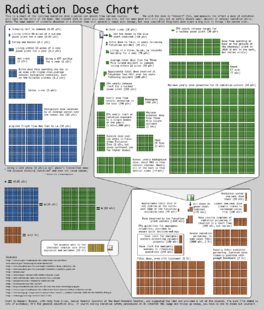Absorbed dose
Absorbed dose is a physical dose quantity D representing the mean energy imparted to matter per unit mass by ionizing radiation. In the SI system of units, the unit of measure is joules per kilogram, and its special name is gray (Gy).[1] The non-SI CGS unit rad is sometimes also used, predominantly in the USA.
Uses

Absorbed dose is used in the calculation of dose uptake in living tissue in both radiation protection and radiology. It is also used to directly compare the effect of radiation on inanimate matter.
Radiological protection
The quantity absorbed dose is of fundamental importance in radiological protection for calculating radiation dose. However, absorbed dose is a physical quantity and used unmodified is not an adequate indicator of the likely health effects in humans.
It has been found that for stochastic radiation risk (defined as probability of cancer induction and genetic effects) consideration must be given to the type of radiation and the sensitivity of the irradiated tissues, which requires the use of modifying factors. Conventionally therefore, unmodified absorbed dose is not used for comparing stochastic risks but only used to compare against deterministic effects (severity of acute tissue effects that are certain to happen) such as in acute radiation syndrome.
To represent stochastic risk the equivalent dose H T and effective dose E are used, and appropriate dose factors and coefficients are used to calculate these from the absorbed dose.[2] Equivalent and effective dose quantities are expressed in units of the sievert or rem which implies that biological effects have been taken into account. These are usually in accordance with the recommendations of the International Committee on Radiation Protection (ICRP) and International Commission on Radiation Units and Measurements (ICRU). The coherent system of radiological protection quantities developed by them is shown in the accompanying diagram.
Radiology
The measurement of absorbed dose in tissue is of fundamental importance in radiobiology and radiation therapy as it is the measure of the amount of energy the incident radiation is imparting to the target tissue.
Component survivability
Absorbed dose is used to rate the survivability of devices such as electronic components in ionizing radiation environments.
Food irradiation

Absorbed dose is the physical dose quantity used to ensure irradiated food has received the correct dose to ensure effectiveness. Variable doses are used depending on the application and can be as high as 70 kGy.
Computation
The absorbed dose is equal to the radiation exposure (ions or C/kg) of the radiation beam multiplied by the ionization energy of the medium to be ionized.
For example, the ionization energy of dry air at 20 °C and 101.325 kPa of pressure is 33.97±0.06 J/C.[3]:305 (33.97 eV per ion pair) Therefore an exposure of 2.58×10−4 C/kg (1 roentgen) would deposit an absorbed dose of 8.76×10−3 J/kg (0.00876 Gy or 0.876 rad) in dry air at those conditions.
When the absorbed dose is not uniform, or when it is only applied to a portion of a body or object, an absorbed dose representative of the entire item can be calculated by taking a mass-weighted average of the absorbed doses at each point.
More precisely,[4]
Where
- is the mass-averaged absorbed dose of the entire item T
- is the item of interest
- is the absorbed dose as a function of location
- is the density as a function of location
- is volume
Medical considerations
Non-uniform absorbed dose is common for soft radiations such as low energy x-rays or beta radiation. Self-shielding means that the absorbed dose will be higher in the tissues facing the source than deeper in the body.
The mass average can be important in evaluating the risks of radiotherapy treatments, since they are designed to target very specific volumes in the body, typically a tumour. For example, if 10% of a patient's bone marrow mass is irradiated with 10 Gy of radiation locally, then the absorbed dose in bone marrow overall would be 1 Gy. Bone marrow makes up 4% of the body mass, so the whole-body absorbed dose would be 0.04 Gy. The first figure (10 Gy) is indicative of the local effects on the tumour, while the second and third figure (1 Gy and 0.04 Gy) are better indicators of the overall health effects on the whole organism. Additional dosimetry calculations would have to be performed on these figures to arrive at a meaningful effective dose, which is needed to estimate the risk of cancer or other stochastic effects.
When ionizing radiation is used to treat cancer, the doctor will usually prescribe the radiotherapy treatment in units of gray. Medical imaging doses may be described in units of coulomb per kilogram, but when radiopharmaceuticals are used, they will usually be administered in units of becquerel.
Radiation-related quantities

The following table shows radiation quantities in SI and non-SI units.
| Quantity | Name | Symbol | Unit | Year | System |
|---|---|---|---|---|---|
| Exposure (X) | röntgen | R | esu / 0.001293 g of air | 1928 | non-SI |
| Absorbed dose (D) | erg•g−1 | 1950 | non-SI | ||
| rad | rad | 100 erg•g−1 | 1953 | non-SI | |
| gray | Gy | J•kg−1 | 1974 | SI | |
| Activity (A) | curie | Ci | 3.7 × 1010 s−1 | 1953 | non-SI |
| becquerel | Bq | s−1 | 1974 | SI | |
| Dose equivalent (H) | röntgen equivalent man | rem | 100 erg•g−1 | 1971 | non-SI |
| sievert | Sv | J•kg−1 | 1977 | SI | |
| Fluence (Φ) | (reciprocal area) | cm−2 or m−2 | 1962 | SI (m−2) |
Although the United States Nuclear Regulatory Commission permits the use of the units curie, rad, and rem alongside SI units,[5] the European Union European units of measurement directives required that their use for "public health ... purposes" be phased out by 31 December 1985.[6]
See also
- Specific absorption rate
- kerma (physics)
- Category:Units of radiation dose
References
- ↑ ICRP 2007, glossary.
- ↑ ICRP 2007, paragraphs 104 and 105.
- ↑ Podgorsak, E. B., ed. (2005). Radiation Oncology Physics: A Handbook for Teachers and Students (PDF). Vienna: International Atomic Energy Agency. ISBN 92-0-107304-6. Retrieved 25 November 2012.
- ↑ ICRP 2007, p. 1.
- ↑ 10 CFR 20.1004. US Nuclear Regulatory Commission. 2009.
- ↑ The Council of the European Communities (1979-12-21). "Council Directive 80/181/EEC of 20 December 1979 on the approximation of the laws of the Member States relating to Unit of measurement and on the repeal of Directive 71/354/EEC". Retrieved 19 May 2012.
Literature
- ICRP (2007). "The 2007 Recommendations of the International Commission on Radiological Protection". Annals of the ICRP. ICRP publication 103. 37 (2-4). ISBN 978-0-7020-3048-2. Retrieved 17 May 2012.
External links
- Specific Gamma-Ray Dose Constants for Nuclides Important to Dosimetry and Radiological Assessment, Laurie M. Unger and D. K . Trubey, Oak Ridge National Laboratory, May 1982 - contains gamma-ray dose constants (in tissue) for approximately 500 radionuclides.